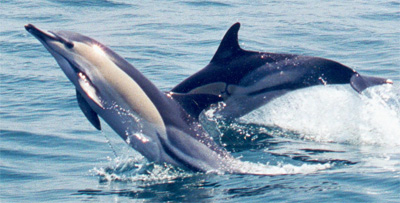Common Dolphin (Delphinus Delphis)

Latin name: Delphinus delphis
Common name: Common dolphin
In other languages: E: Delfin comun, F: Dauphin Commun, D: Gemeiner Delfin
Class: Mammalia
Order: Cetacea
Suborder: Odontoceti
Family: Delphinidae
Genus: Delphinus
Life Span: 20 to 25 years.
Reproduction: Sexual maturation occurs at the age of five years. The gestation period is eleven months.
 Behaviour: Dolphins move in groups of between 10 and 50 members. They are known for their playful behaviour. At times they gather in groups of up to 2,000 animals and also occasionally mix with other types of dolphins and whales such as the killer whale. They ride the bow waves of vessels varying from large ships to small sailing boats.
Behaviour: Dolphins move in groups of between 10 and 50 members. They are known for their playful behaviour. At times they gather in groups of up to 2,000 animals and also occasionally mix with other types of dolphins and whales such as the killer whale. They ride the bow waves of vessels varying from large ships to small sailing boats.
Diet: Fish, squid and crustaceans.
Size: Common: 150cm, maximum: 260cm.
Enemies: The worst thread is of human nature: pollution of water, collusion with industrial trawler fishing nets, distress caused by 'hunters' of dolphin safaris.
Did you know? They have been seen riding the bow waves of war ships travelling at speeds up to 32 knots. It is this friendly approach that has cost this species dearly. In the Black Sea they are taken in purse-seine nets. Off the west coast of Italy they are taken in a bloody slaughter to make a delicacy called muscaim. In the Strait of Gibraltar many have been washed ashore, some with gunshot wounds, some of them mutilated (tail flukes cut off).
Mythology & Fable: The name 'dolphin' stems from the oracle of delphi.
The fish as symbol of christianity originally depicted a dolphin.
In Medival art the dolphin symbolises social love.
In classical times the dolphin was seen by many as a herald to the Gods and was treated with due respect.
In Aesop's fables the dolphin was said to be the voice of reason, a reputation the dolphin has sadly lost in today's world.